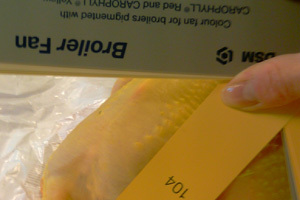The effect of carotenoids on yolk and skin pigmentation

Not all carotenoids are the same when it comes to yolk and skin pigmentation. As markets have different preferences for yolk and/or skin colours, it is of utmost importance to understand the colouring effect of different carotenoids used in poultry feeds.
The most important carotenoids in modern poultry production include lutein, zeaxanthin, and canthaxanthin. Less frequent ones include citranaxanthin (only in eggs), apo-carotene-ester, and the infrequently used capsanthin. Under commercial conditions, carotenoids are provided by the ingredients mentioned in Table 1: yellow corn and derivates such as gluten and distillers grains; alfalfa and concentrate; nature-identical or nature-extracted carotenoids (flowers like marigold/tagetes or paprika). Yellow carotenoids mainly originate in vegetable sources. For example, lutein and zeaxanthin are found in corn and its derivatives. Lutein is the main carotenoid in alfalfa and tagetes. Paprika extracts provide red carotenoids, mainly capsanthin and capsorubin, but they also contain lutein and zeaxanthin. Apo–ester, canthaxanthin, and citranaxanthin are commercially available sources of nature-identical carotenoids. Today, due to its high pigmentation efficacy compared to citranaxanthin, canthaxanthin is the preferred red xanthophyll in poultry production.
Yolk colour can be determined basically by two methods. An objective method uses a mechanical equipment (for example, MiniScan XE HunterLab, Minolta colourimeter CR 300) that expresses colouration in the so-called HunterLab scale (L, lightness; a, redness; and b, yellowness). A simple but subjective method involves the DSM Yolk Colour Fan that expresses results in a 1 to 15 scale by means of comparison with calibrated cards. Both systems are well correlated but because the DSM Fan is more economical and readily available it has become the preferred method in most parts of the world. With regards to the products containing eggs, both methods are suitable, but for scores higher than 15, the DSM Fan is insufficient. For this purpose, a new and fast method based on spectrophotometry can determine carotenoid content expressed as beta-carotene equivalents (BCE): the iCheck Egg. This fast method is perfectly correlated with the equivalent standardised method carried out in laboratory.
Compared to yolks which have homogeneous colour, broiler skin is much more difficult to assess because carcass colour is more heterogeneous. Colour can be assessed by the DSM Broiler Fan, expressed in a 101-110 scale, or by a colourimeter, as above. The results can vary according to the protocol. Ideally, measurements must be carried out on the fatty part of the breast collected after chilling. Sex (female birds have darker skin colour) and genotype are also important factors of variability.
Synthetic products are standardised and more stable than extracted products. For example, in one study, apo-carotene-ester concentration in feed samples showed very little variation from expected values, whereas it was 30% below expectations for marigold extracts. Esterification and saponification usually helps to produce better stable tagetes and paprika products; the same as spray-drying protection, but there is a wide variation in the quality of the coating. For example, the stability of various red carotenoids products in premixes was checked after three months of storage and recovery varied considerably: 66% to 92% for canthaxanthin, 76% for citranaxanthin, and 39% for capsanthin from paprika. Carotenoids are very unstable on their isomeric forms; the trans-configuration is the most common, found in the yolk, but the cis-configuration (less efficient for pigmentation) can be produced when heat, light, or oxygen damage occurs. Good coating usually prevents such damage.
In broilers, zeaxanthin influences the yellow value in all tissues, more noticeably in the abdominal fat, with lutein and zeaxanthin being deposited in skin and fat with a rate of 8-12% and 4-9%, respectively. In broilers, the deposition of the isomerised tagetes (enriched in zeaxanthin) is lower than the standard tagetes (mostly lutein), whereas contents of apo-carotene-ester increases in skin and abdominal fat with increasing supplementation of this carotenoid, reflecting a linear increase over the entire dose range (not common among other carotenoids).
There are two components of the pigmentation process. The first refers to the saturation phase and involves the deposition of yellow carotenoids to create the yellow base (about 7 on the DSM Yolk Fan). Then the addition of red carotenoids is called colour phase and changes the hue in a more orange colour. For table eggs, quantities of yellow and red carotenoids can be added depending on market requirements (Table 2). Feed supplementation should be implemented for at least 10 days to ensure a constant colour. For processed eggs, the requirement for yellow base is higher. When specification is above 20 ppm BCE (above 15 on the DSM Fan), it is better recommended to formulate according to the BCE value. High concentrations of apo-carotene-ester in the feed are frequently necessary to fulfil the requirements such as pasta production.












